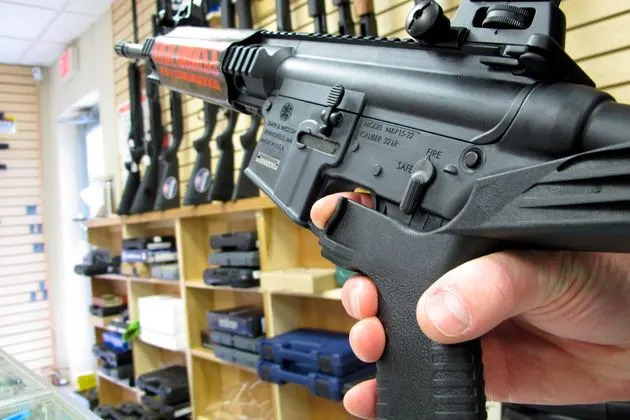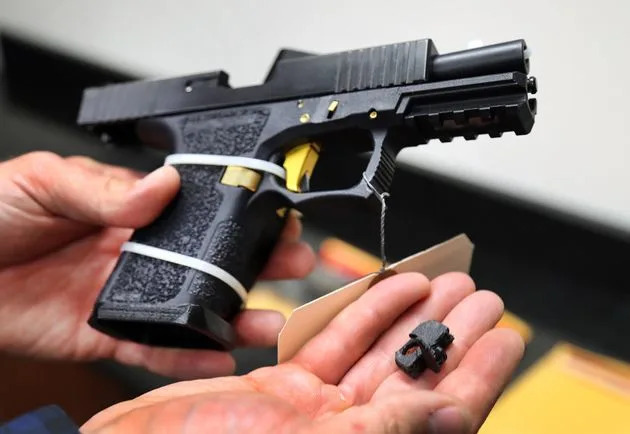Illustration: Benjamin Currie/HuffPost
In a video clip uploaded three months ago, one of YouTube’s most prominent gun reviewers took aim at a steel target with a Glock 17 pistol equipped with a device called an autosear.
“All right, full auto!” he said as about half the spray of bullets ricocheted off the coffin-shaped target while the rest flew into the dirt behind it. He burst through the entire magazine in less than a second.
“I can’t believe how many rounds I burned through already,” Hickok45 said after ringing more steel, then exploding a terra cotta pot, popping several soda bottles and knocking over a bowling pin. “It’s fun. And we wanted to bring the fun to you.” The video has attracted 681,000 views.
Congress first tightened regulation of machine guns back in 1934, in response to Prohibition-era gang violence. Modern machine guns and conversion devices have been banned from civilian use since 1986. Unlawful possession of an autosear can land an offender in prison for up to a decade, whether or not the device is attached to a pistol.
But machine guns are making a fast comeback.
Tinkerers are constantly devising new ways to shoot semiautomatics faster. The 3D printer has made it possible to turn a common pistol into a machine gun for less than $100. And the spread of information in the digital age has made it easier for enthusiasts like Greg Kinman of Tennessee, who posts on social media as Hickok45, to jump through the hoops necessary to buy or build fully automatic weapons legally.
That rapidly growing market has created new challenges for law enforcement. The Bureau of Alcohol, Tobacco, Firearms and Explosives (ATF) is waging a public education campaign to help dispel the notion that machine gun conversion devices like the ones portrayed in Hickok45′s video are legal. Some Democratic-led jurisdictions are taking legal action against Glock in an attempt to make its guns harder to modify.
But lawmakers and regulators face a complex problem that piecemeal efforts are unlikely to solve. The result is that faster-shooting guns — both legal and illegal — are likely to become an increasingly common fact of modern American life.
Civilian-Legal Machine Guns
Machine guns have played a niche role in the civilian firearms market for about as long as they’ve existed.
Congress sharply restricted civilian access with the National Firearms Act of 1934 (NFA) but didn’t ban machine guns entirely. Instead, it required civilians to register fully automatic weapons and pay a $200 tax each time one changes hands. The transfer cost — roughly equivalent to $4,732 today, after nearly a century of inflation — made machine gun ownership prohibitively expensive for most Americans.
Congress did not criminalize civilian machine gun possession until it passed the Firearm Protection Act of 1986. That law, however, allowed machine guns produced on or before that year. About one-third of the states prohibit machine guns, regardless of when they were made.
Americans who want to buy a legal machine gun today need to track down a legally registered one, apply for a transfer and pay the tax — which is still $200. The tight supply of pre-1986 machine guns means that most of them easily fetch five-figure prices.
As of 2021, Americans had registered about 741,000 machine guns in the United States under this process, according to ATF data, up from 457,000 in 2011.
It’s hard to tell what that 62% jump in federally registered automatic weapons really means because the ATF does not publish how many of those weapons are in civilian hands. Private sellers who make or sell modern automatic firearms directly to law enforcement agencies also have to register them under the NFA, which lumps them into the same statistical category as civilian-owned, pre-1986 machine guns.
A Tinkering Renaissance
The biggest growth in legal access to faster rates of fire has come from tinkerers who have spent the last two decades devising ways to make semiautomatic guns fire faster.
Manufacturers submit new designs for products that will make guns fire faster to the ATF to assess their legality before taking them to market. The federal definition of a machine gun is one that fires multiple shots by a “single function of the trigger.” That wording gives creative minds a lot of leeway.
The Akins Accelerator, patented in 2000, pioneered the technique of harnessing a semiautomatic rifle’s recoil to make it shoot faster. The spring-operated sliding stock allowed the gun to move back and forth in the shooter’s hands. By pushing forward with the non-shooting hand and keeping pressure against the trigger, the shooter could fire bullets at a rate of about 800 per minute.
The ATF approved it in 2002. Then, in 2005, the agency changed its mind, issuing a new rule that classified the Akins Accelerator as a machine gun.
By then, however, a separate device based on the Akins Accelerator, the “bump stock,” had hit the market. The only significant difference between the two items was that the bump stock lacked the spring found inside the Akins Accelerator. Still, the ATF classified bump stocks as firearm parts instead of machine guns, allowing their sale to civilians for more than a decade.
An employee of North Raleigh Guns in Raleigh, North Carolina, demonstrates how a bump stock works in 2013. via Associated Press
That changed with the 2017 mass shooting at the Route 91 Harvest Festival on the Las Vegas Strip, when a gunman on the 32nd floor of a hotel sprayed more than 1,000 rounds into the crowd below from semiautomatic rifles equipped with extended magazines and bump stocks. The shooting left 60 dead and more than 850 injured, making it the deadliest mass shooting carried out by a lone gunman in American history.
The massacre fostered wide bipartisan consensus in favor of banning bump stocks. But Congress did not move forward with a bill. Instead, then-President Donald Trump directed the ATF to reclassify bump stocks as machine guns.
That strategy frustrated the gun industry and reformers alike. The National Shooting Sports Federation (NSSF), the trade group for the firearms industry, faulted the ATF for reversing its decision instead of deferring to Congress.
“People build businesses around ATF’s determination letters, but when it became politically expedient, the ATF pulls the rug out and moves the goal posts,” said Larry Keane, NSSF’s senior vice president and general counsel. “The ATF is making law and exceeding the statute that Congress wrote.”
Eric Rubin, a legal fellow at the Brennan Center for Justice at New York University, also questioned the legal logic of shoehorning bump stocks into a definition for “machine guns” written in the 1930s instead of more straightforward congressional action.
“There’s a story of political dysfunction when it comes to bump stocks that has gotten overlooked. How is it that a device that resulted in the worst mass shooting in American history — and that says a lot — and has no utility for self-defense or hunting can’t be banned through a law?” Rubin said. “Legislators should respond in an ideal world, when that’s consistent with the will of the electorate. We can’t stop technology from advancing.”
Austin, Texas, gun store owner and firearms instructor Michael Cargill sued the ATF the day the bump stock ban went into effect, arguing that only Congress had the power to change the rule and that a bump stock did not meet the definition of automatic fire because the shooter still physically taps the trigger every time a shot is fired.
The U.S. Supreme Court appeared sympathetic to Cargill’s arguments when it heard the case in February, repeatedly questioning Deputy Solicitor General Brian Fletcher about why Congress hadn’t specifically banned the devices and raising concerns that people who had bought the devices legally would be exposed to felony prosecution because of the ATF’s flip-flopping. The Supreme Court is expected to rule on the case next month.
Regardless of how they rule, people still have easy access to semiautomatics that shoot with similar speed. The binary trigger, for example, allows the shooter to fire a round when pulling the trigger and another when releasing, effectively doubling the rate of fire of semiautomatic weapons. The ATF does not classify the binary trigger as a machine gun because it counts the pull and release of the trigger as two separate functions of the trigger instead of a single function.
And those willing to take the time to learn can bump-fire pretty much any semiautomatic weapon using only their hands and a rubber band or belt loop.
Federally Licensed YouTubers
Enthusiasts who want truly unfettered access to modern machine guns are taking advantage of the most glaring loophole by becoming federally licensed firearms dealers.
Individuals can obtain a Federal Firearms License, or FFL, and sell guns out of their homes. An FFL holder can then apply for a Special Occupational Tax, or SOT, that allows the holder to possess and transfer modern machine guns legally. A separate SOT allows the holder to build machine guns, including at home.
Kinman did not respond to a request for comment for this story, but the Hickok45 poster says in one of his videos that he holds an FFL/SOT combination that allows him to possess automatic weapons legally.
Those who deal in machine guns are free to shoot them, noted Cargill. Cargill holds an FFL/SOT combination that allows him to manufacture automatic weapons.
“I can build my own machine gun — a modern-day machine gun,” Cargill said. “I can take it to the range and shoot it every day, as long as that machine gun comes back to the store every night. It has to go to sleep in the gun store.”
A longstanding ATF ruling holds that making legally obtained machine guns available for others to shoot at an onsite shooting range owned by the FFL holder is “not considered to be a sale, disposition, or delivery of the firearms,” an ATF official wrote in an email to HuffPost. “The on-premises rental of NFA firearms owned by an FFL is therefore permitted.”
The ATF requires machine gun sellers to have a business intent when applying for their license — it’s not supposed to act as a backdoor to owning machine guns.
“It has to be for a legal purpose,” an ATF official told HuffPost. “It cannot just be, ‘I got my FFL and SOT — I’m going to go and make all the machine guns I want.’ You cannot do that.”
Several companies online offer to help the average citizen get their hands on a machine gun, often emphasizing the novelty of being able to access post-1986 machine guns. YouTube is chock-full of machine gun demonstrations by people claiming to possess legal authority to shoot automatic weapons.
“This is a machine gun,” a YouTuber who posts as “PSR” says in one video. “This is a Glock switch. It is not mine. I am not in possession of it. I am on the range and my friend, who has an FFL07, SOT Class 2, is the owner of this machine gun.”
“While there are plenty of people running around with these illegally, of course, this is one that is legal, and my friend behind the camera is supervising me as I test fire this machine gun,” the YouTuber added. “With that said. Fuck the NFA. Fuck the machine gun ban.”
A Thriving Black Market
The same tinkering that birthed bumps stocks has turbocharged the black market for automatic weapons. It doesn’t take much technical expertise to convert many semiautomatic firearms into automatic ones. Attaching an autosear, like the one in Hickok45′s video, onto the firearm will do the job.
The autosear has existed for a long time. But over the last few years, autosears fitted for Glock pistols have proliferated to such a degree that many people have come to call them “Glock switches.”
The overwhelming majority of them are made illegally with 3D printers or sold on shady websites and imported from China and Russia. They often come equipped with trademark-infringing branding that gives the false impression that they’re made by Glock itself.
The ATF has confiscated some 31,000 of them over the last five years. Glocks equipped with switches are increasingly showing up at crime scenes — most notably a mass shooting in Sacramento that left six dead and a dozen more wounded in 2022.
The Boston bureau of the ATF shows a machine gun conversion device for a Glock handgun. The device, which can be made with a 3D printer, can convert the Glock into a machine gun after the "switch" is installed. John Tlumacki/The Boston Globe via Getty Images
Reformers have taken aim at Glock itself, accusing the gun maker of failing to act while criminals take advantage of a flaw in its pistols’ design. Unlike many other popular pistols, Glocks typically feature a removable slide plate. Once removed, turning the pistol into an automatic weapon is a simple job — a small protrusion from the autosear blocks a part of the gun called the trigger bar from rising and halting the firing pin from firing another round.
The city of Chicago sued Glock last month under a new Illinois law that exposes firearm manufacturers to civil claims from people harmed by gun violence. The lawsuit asks the courts to force Glock to modify its pistol designs to make them harder to convert into machine guns.
The city of Honolulu voted last monthto file a similar lawsuit, though it has yet to do so. And this month, New York state Sen. Zellnor Myrie filed a bill that would ban the sale of “easily modified pistols.” Though the text names no brand, Myrie’s proposition was directed squarely at Glock.
Glock did not respond to HuffPost’s requests for comment about the legal actions filed against it.
But the National Shooting Sports Federation, the firearm industry trade group, views the attacks on Glock as misguided and questions the legal logic of the proposed New York bill. The proposal, which lacks a technical definition of “easily modifiable pistol,” would criminalize pretty much all striker-fired pistols, according to Keane.
“Changing the design of a gun is not an easy thing to do,” Keane said. “[Glock] is doing what it can, but changing the design and making a less-reliable design is not advisable. … Reliability is safety.”
Even if reformers compelled Glock to modify its design tomorrow, there would still be millions of the current generations lingering on the market indefinitely. Those willing to break the law would have a wide array of options for turning semiautomatic firearms into fully automatic weapons. Other pistol-makers struggle with the same problem of black market modifications as Glock. And firearms are simple machines. A savvy enthusiast can turn an an AR-15 into a machine gun with a coat hanger.
“It’s not difficult to do any of this stuff,” said Cargill, the gun store owner. “It’s a matter of do you want to become a felon or not. Most people want to do things the right way.”

 German (DE)
German (DE)  English (US)
English (US)  Spanish (ES)
Spanish (ES)  French (FR)
French (FR)  Hindi (IN)
Hindi (IN)  Italian (IT)
Italian (IT)  Russian (RU)
Russian (RU) 

























Comments